Nonmetal - Study guides, Class notes & Summaries
Looking for the best study guides, study notes and summaries about Nonmetal? On this page you'll find 675 study documents about Nonmetal.
Page 2 out of 675 results
Sort by
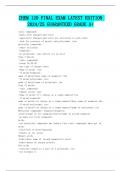
-
CHEM 120 FINAL EXAM LATEST EDITION 2024/25 GUARANTEED GRADE A+
- Exam (elaborations) • 5 pages • 2024
-
- $8.89
- + learn more
ionic compounds -deals with charged particles -oppositely charged particles are attracted to each other -look for presence of metals and polyatomic ions molecular compounds -share electrons -nonmetals -no polyatomic ions unless its an acid Type I metals -ionic compounds -group 1A,2A,3A -one type of charge state -Name of metal +ion -if metal+nonmetal: name of metal+base name of nonmetal +ide -if metal+polyatomic ion: name of metal+name of polyatomic ion Type II metals -ionic com...

-
CHEM 104 Module 2: Exam (Portage learning)
- Exam (elaborations) • 18 pages • 2023
-
- $21.49
- + learn more
Identify each of the compounds below as ACID, BASE or SALT on the basis of their formula and explain your answer. (1) MgCl (2) HClO (3) Cu(OH) 2 4 2 1.) MgCl2 This is a salt because Mg ( metal) and Cl is a nonmetal 2.) HCIO4 This is a Acid because H infront and Cl is a nonmetal 3) Cu(OH)2 This is a BASE because it has OH and the Cu is a metal MgCl Salt Contains Metal (Mg) + Nonmetal (Cl) HClO Acid Contains H + Polyatomic group (ClO ) Cu(OH) Base Contains Metal (Cu) + OH Polya...
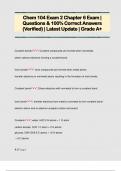
-
Chem 104 Exam 2 Chapter 6 Exam | Questions & 100% Correct Answers (Verified) | Latest Update | Grade A+
- Exam (elaborations) • 20 pages • 2024
-
- $11.49
- + learn more
Covalent bonds: Covalent compounds are formed when nonmetals share valence electrons forming a covalent bond. Ionic bonds: Ionic compounds are formed when metal atoms transfer electrons to nonmetal atoms resulting in the formation of ionic bonds. Covalent bond: Share electrons with nonmetal to form a covalent bond Ionic bond: transfer electrons from metal to nonmetal to form covalent bond - electron donor and an electron acceptor (cation and anion) Covalent: water, H2O 2 H atoms + 1 O ato...
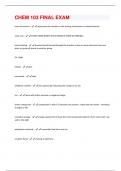
-
CHEM 103 FINAL EXAM QUESTIONS & ANSWERS VERIFIED 100% CORRECT
- Exam (elaborations) • 31 pages • 2024
- Available in package deal
-
- $7.99
- + learn more
Lewis Structures - represents the transfer or the sharing of electrons in chemical bonds octet rule - EVERY ATOM WANTS 8 ELECTRONS IN THEIR OUTERSHELL ionic bonding - chemical bond formed through the transfer of one or more electrons from one atom or group of atoms to another group EX : NaBr metals - give nonmetals - take oxidation number - the superscript indicating the charge on an ion ion - atom with either positive or negative charge binary compound - compounds in which 2 elements a...
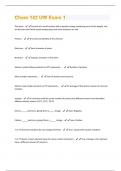
-
Chem 142 UW Exam 1 All Possible Questions and Answers with complete solution
- Exam (elaborations) • 13 pages • 2024
- Available in package deal
-
- $10.19
- + learn more
The atom - Consists of a small nucleus with a positive charge containing most of the weight. Has an electron cloud with mostly empty space but some electrons as well Protons - The chemical identity of the element Electrons - Ionic character of atom Neutrons - Isotopic character of the atom Atomic number (Above element on PT) represents... - Number of protons Mass number represents... - Sum of protons and neutrons Atomic mass (Under element on PT) represents... - An average of the atomic m...
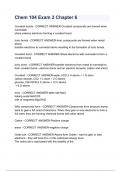
-
Chem 104 Exam 2 Chapter 6 complete solution 2023/2024
- Exam (elaborations) • 13 pages • 2024
-
- $7.99
- + learn more
Covalent bonds - CORRECT ANSWER-Covalent compounds are formed when nonmetals share valence electrons forming a covalent bond. Ionic bonds - CORRECT ANSWER-Ionic compounds are formed when metal atoms transfer electrons to nonmetal atoms resulting in the formation of ionic bonds. Covalent bond - CORRECT ANSWER-Share electrons with nonmetal to form a covalent bond Ionic bond - CORRECT ANSWER-transfer electrons from metal to nonmetal to form covalent bond - electron donor and an electron ac...

-
Florida Funeral Laws Test questions and answers 2024
- Exam (elaborations) • 42 pages • 2024
-
Available in package deal
-
- $7.99
- + learn more
Florida Funeral Laws Test questions and answers 2024 Alternative Container - ANSWER-Unfinished wood box or other nonmetal receptacle or enclosure, without ornamentation or a fixed interior lining, that is designed for the encasement of human remains and that is made of fiberboard, pressed wood, composition materials, or like material At-Need Solicitation - ANSWER-Any uninvited contact by a licensee or his or her agent for the purpose of the sale of burial services or merchandise to the fam...
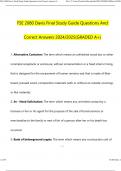
-
Florida Funeral Laws Questions and Answers (100% accurate).
- Exam (elaborations) • 89 pages • 2024
-
- $10.49
- + learn more
Alternative Container - ANSWER-Unfinished wood box or other nonmetal receptacle or enclosure, without ornamentation or a fixed interior lining, that is designed for the encasement of human remains and that is made of fiberboard, pressed wood, composition materials, or like material At-Need Solicitation - ANSWER-Any uninvited contact by a licensee or his or her agent for the purpose of the sale of burial services or merchandise to the family or next of kin of a person after his or her death has o...

-
KSU Patell Chem 210 Exam 2 Correct 100%
- Exam (elaborations) • 4 pages • 2024
-
Available in package deal
-
- $11.49
- + learn more
ionic bond - ANSWERmetal and nonmetal covalent bond - ANSWERtwo nonmetals how to name an ionic compound? - ANSWERname the cation (metal) and then the anion (nonmetal), but replace the ending of the anion with -ide Na+ - ANSWERsodium Li+ - ANSWERlithium K+ - ANSWERpotassium Ca2+ - ANSWERcalcium mg2+ - ANSWERmagnesium Cs+ - ANSWERcesium Al3+ - ANSWERaluminum Ba2+ - ANSWERbarium Sr2+ - ANSWERstrontium
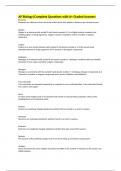
-
AP Biology|Complete Questions with A+ Graded Answers
- Exam (elaborations) • 37 pages • 2024
-
- $13.59
- + learn more
AP Biology|Complete Questions with A+ Graded Answers Elements Elements are substances that cannot be broken down into simpler substances by chemical means. Oxygen Oxygen is an element with symbol O and atomic number 8. It is a highly reactive nonmetal and oxidizing agent. In living organisms, oxygen is used in respiration and in a number of organic molecules. Carbon Carbon is an non mental element with symbol O and atomic number 6. It is the second most abundant element in living o...

Do you wonder why so many students wear nice clothes, have money to spare and enjoy tons of free time? Well, they sell on Stuvia! Imagine your study notes being downloaded a dozen times for $15 each. Every. Single. Day. Discover all about earning on Stuvia


